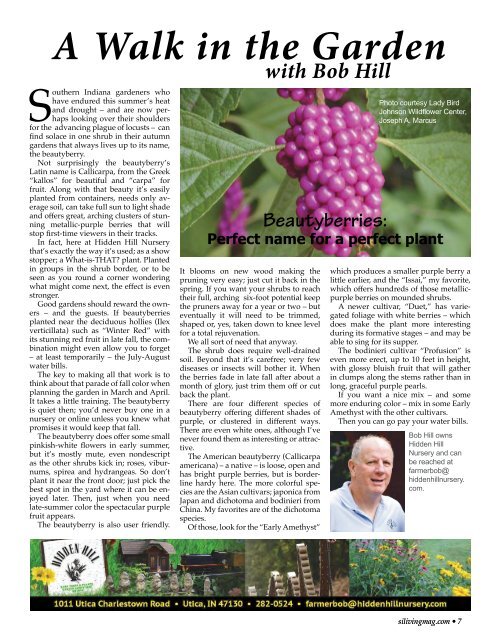You also want an ePaper? Increase the reach of your titles
YUMPU automatically turns print PDFs into web optimized ePapers that Google loves.
A Walk in the Garden<br />
with Bob Hill<br />
<strong>Southern</strong> <strong>Indiana</strong> gardeners who<br />
have endured this summer’s heat<br />
and drought – and are now perhaps<br />
looking over their shoulders<br />
for the advancing plague of locusts – can<br />
Ànd solace in one shrub in their autumn<br />
gardens that always lives up to its name,<br />
the beautyberry.<br />
Not surprisingly the beautyberry’s<br />
Latin name is Callicarpa, from the Greek<br />
“kallos” for beautiful and “carpa” for<br />
fruit. Along with that beauty it’s easily<br />
planted from containers, needs only average<br />
soil, can take full sun to light shade<br />
and oers great, arching clusters of stunning<br />
metallic-purple berries that will<br />
stop Àrst-time viewers in their tracks.<br />
In fact, here at Hidden Hill Nursery<br />
that’s exactly the way it’s used; as a show<br />
stopper; a What-is-THAT? plant. Planted<br />
in groups in the shrub border, or to be<br />
seen as you round a corner wondering<br />
what might come next, the eect is even<br />
stronger.<br />
Good gardens should reward the owners<br />
– and the guests. If beautyberries<br />
planted near the deciduous hollies (Ilex<br />
verticillata) such as “Winter Red” with<br />
its stunning red fruit in late fall, the combination<br />
might even allow you to forget<br />
– at least temporarily – the July-August<br />
water bills.<br />
The key to making all that work is to<br />
think about that parade of fall color when<br />
planning the garden in March and April.<br />
It takes a little training. The beautyberry<br />
is quiet then; you’d never buy one in a<br />
nursery or online unless you knew what<br />
promises it would keep that fall.<br />
The beautyberry does o er some small<br />
pinkish-white Áowers in early summer,<br />
but it’s mostly mute, even nondescript<br />
as the other shrubs kick in; roses, viburnums,<br />
spirea and hydrangeas. So don’t<br />
plant it near the front door; just pick the<br />
best spot in the yard where it can be enjoyed<br />
later. Then, just when you need<br />
late-summer color the spectacular purple<br />
fruit appears.<br />
The beautyberry is also user friendly.<br />
It blooms on new wood making the<br />
pruning very easy; just cut it back in the<br />
spring. If you want your shrubs to reach<br />
their full, arching six-foot potential keep<br />
the pruners away for a year or two – but<br />
eventually it will need to be trimmed,<br />
shaped or, yes, taken down to knee level<br />
for a total rejuvenation.<br />
We all sort of need that anyway.<br />
The shrub does require well-drained<br />
soil. Beyond that it’s carefree; very few<br />
diseases or insects will bother it. When<br />
the berries fade in late fall after about a<br />
month of glory, just trim them o or cut<br />
back the plant.<br />
There are four di erent species of<br />
beautyberry o ering di erent shades of<br />
purple, or clustered in di erent ways.<br />
There are even white ones, although I’ve<br />
never found them as interesting or attractive.<br />
The American beautyberry (Callicarpa<br />
americana) – a native – is loose, open and<br />
has bright purple berries, but is borderline<br />
hardy here. The more colorful species<br />
are the Asian cultivars; japonica from<br />
Japan and dichotoma and bodinieri from<br />
China. My favorites are of the dichotoma<br />
species.<br />
Of those, look for the “Early Amethyst”<br />
Photo courtesy Lady Bird<br />
Johnson WildÀower Center,<br />
Joseph A. Marcus<br />
Beautyberries:<br />
Perfect name for a perfect plant<br />
which produces a smaller purple berry a<br />
little earlier, and the “Issai,” my favorite,<br />
which o ers hundreds of those metallicpurple<br />
berries on mounded shrubs.<br />
A newer cultivar, “Duet,” has variegated<br />
foliage with white berries – which<br />
does make the plant more interesting<br />
during its formative stages – and may be<br />
able to sing for its supper.<br />
The bodinieri cultivar “Profusion” is<br />
even more erect, up to 10 feet in height,<br />
with glossy bluish fruit that will gather<br />
in clumps along the stems rather than in<br />
long, graceful purple pearls.<br />
If you want a nice mix – and some<br />
more enduring color – mix in some Early<br />
Amethyst with the other cultivars.<br />
Then you can go pay your water bills.<br />
Bob Hill owns<br />
Hidden Hill<br />
Nursery and can<br />
be reached at<br />
farmerbob@<br />
hiddenhillnursery.<br />
com.<br />
silivingmag.com • 7

















